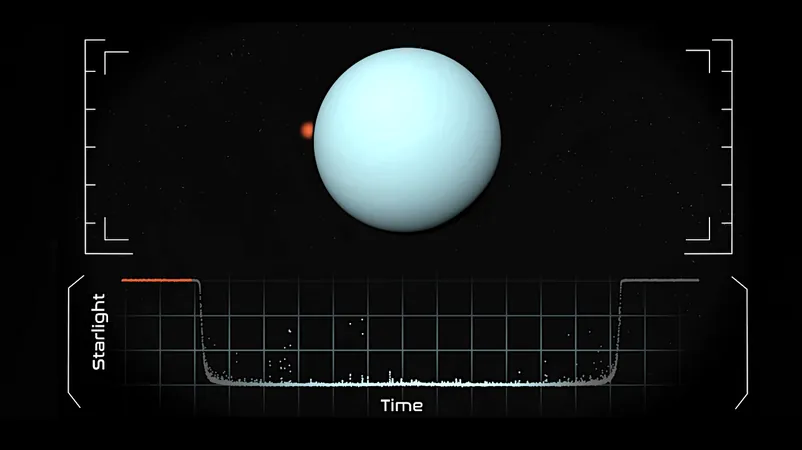
Groundbreaking Discovery: Anomalous Hall Effect Unveiled in New Materials Without Magnetization!
2025-04-18
Author: Sarah
A Team's Revolutionary Breakthrough!
An international research team, spearheaded by Mayukh Kumar Ray, Mingxuan Fu, and Satoru Nakatsuji from the University of Tokyo, alongside Collin Broholm from Johns Hopkins University, has made a groundbreaking discovery—the anomalous Hall effect has been detected in a collinear antiferromagnet.
What Makes This Finding So Unique?
In a remarkable twist, this anomalous Hall effect arises from a non-Fermi liquid state, where electrons behave in ways that defy traditional models of interaction. This revelation not only challenges long-standing scientific theories but also opens new avenues for utilizing antiferromagnets in cutting-edge information technologies.
Understanding Spins in Magnetism!
Spins are fundamental characteristics of electrons, typically depicted as either "up" or "down." In ferromagnets, spins align in the same direction, resulting in magnetization. This magnetization allows for the creation of a voltage that is perpendicular to the electric current—even in the absence of an external magnetic field, a phenomenon known as the anomalous Hall effect.
The Surprising Role of Antiferromagnets!
Antiferromagnets, on the other hand, have spins that counteract each other, suggesting that magnetization—and by extension, the anomalous Hall effect—should not occur within them. Yet, the research team proved this assumption wrong!
Principal investigator Nakatsuji elaborated, "While there have been past reports of the anomalous Hall effect in select collinear antiferromagnets, the signals were disappointingly weak. Our quest for a robust, magnetization-free anomalous Hall effect was of immense scientific significance."
Innovative Experimental Techniques!
The research demanded meticulous collaboration among various teams. Fu and her associates crafted the experimental setup, employing a novel family of materials called transition metal dichalcogenides (TMD) as two-dimensional building blocks. By strategically inserting magnetic ions between atomic layers, they were able to manipulate electron movements and interactions, transitioning the structure from 2D to a new three-dimensional configuration.
Key Discoveries and Challenges!
With this innovative setup, the researchers conducted experiments across a broad spectrum of temperatures and magnetic fields. Broholm's group provided crucial microscopic evidence confirming the collinear antiferromagnetic structure, which was then cross-referenced with theoretical analyses from Ryotaro Arita’s team at UTokyo.
Co-lead Fu noted, "A significant hurdle throughout our research was piecing together a coherent scientific narrative from our findings. Each phase demanded careful interpretation, especially given the structural disorder typical of TMD systems."
What Lies Ahead?
The discovery marks the first robust experimental evidence of the anomalous Hall effect within collinear antiferromagnets. Traditionally, this effect is believed to be tied to magnetization, leading to questions about the underlying physics at play. Researchers now theorize that the unique arrangement of the material's electron bands might create an impressive "virtual magnetic field," crucially enhancing the anomalous Hall effect—even in the absence of magnetization.
Looking forward, Nakatsuji stated, "We aim to attain experimental validation for this hypothesis and are actively engaging in follow-up studies utilizing various techniques, including Raman spectroscopy, to delve deeper into the fundamental mechanisms behind this phenomenon."


 Brasil (PT)
Brasil (PT)
 Canada (EN)
Canada (EN)
 Chile (ES)
Chile (ES)
 Česko (CS)
Česko (CS)
 대한민국 (KO)
대한민국 (KO)
 España (ES)
España (ES)
 France (FR)
France (FR)
 Hong Kong (EN)
Hong Kong (EN)
 Italia (IT)
Italia (IT)
 日本 (JA)
日本 (JA)
 Magyarország (HU)
Magyarország (HU)
 Norge (NO)
Norge (NO)
 Polska (PL)
Polska (PL)
 Schweiz (DE)
Schweiz (DE)
 Singapore (EN)
Singapore (EN)
 Sverige (SV)
Sverige (SV)
 Suomi (FI)
Suomi (FI)
 Türkiye (TR)
Türkiye (TR)
 الإمارات العربية المتحدة (AR)
الإمارات العربية المتحدة (AR)